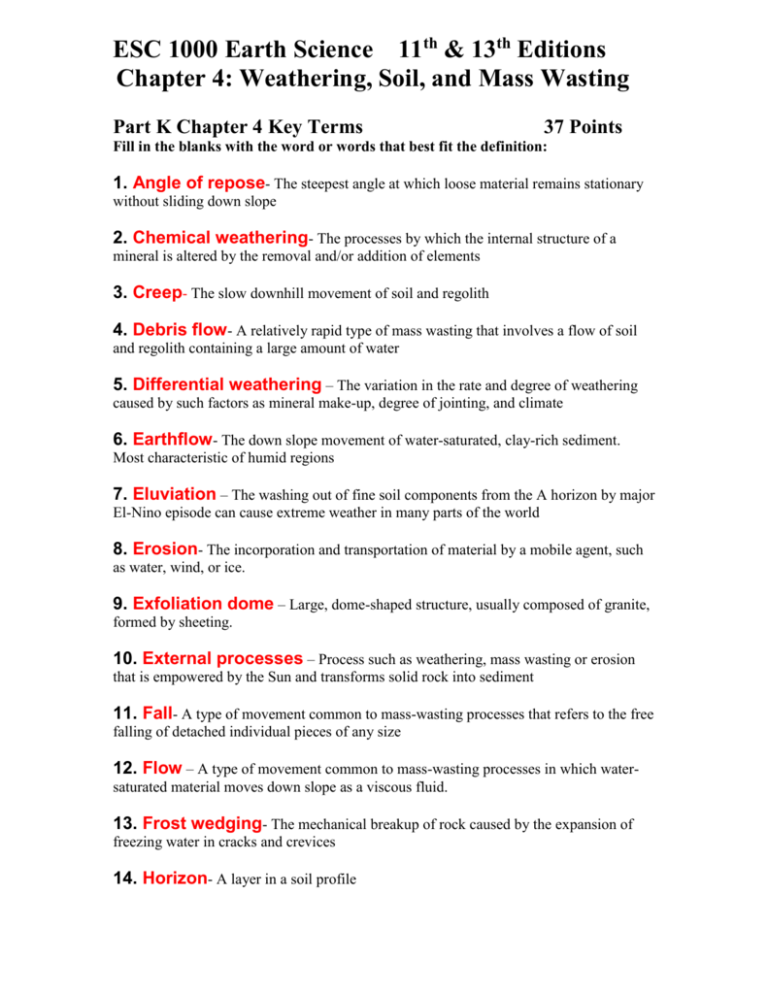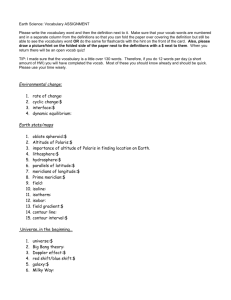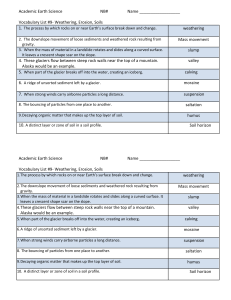Chapter 4 Vocabulary Answers
advertisement

ESC 1000 Earth Science 11th & 13th Editions Chapter 4: Weathering, Soil, and Mass Wasting Part K Chapter 4 Key Terms 37 Points Fill in the blanks with the word or words that best fit the definition: 1. Angle of repose- The steepest angle at which loose material remains stationary without sliding down slope 2. Chemical weathering- The processes by which the internal structure of a mineral is altered by the removal and/or addition of elements 3. Creep- The slow downhill movement of soil and regolith 4. Debris flow- A relatively rapid type of mass wasting that involves a flow of soil and regolith containing a large amount of water 5. Differential weathering – The variation in the rate and degree of weathering caused by such factors as mineral make-up, degree of jointing, and climate 6. Earthflow- The down slope movement of water-saturated, clay-rich sediment. Most characteristic of humid regions 7. Eluviation – The washing out of fine soil components from the A horizon by major El-Nino episode can cause extreme weather in many parts of the world 8. Erosion- The incorporation and transportation of material by a mobile agent, such as water, wind, or ice. 9. Exfoliation dome – Large, dome-shaped structure, usually composed of granite, formed by sheeting. 10. External processes – Process such as weathering, mass wasting or erosion that is empowered by the Sun and transforms solid rock into sediment 11. Fall- A type of movement common to mass-wasting processes that refers to the free falling of detached individual pieces of any size 12. Flow – A type of movement common to mass-wasting processes in which watersaturated material moves down slope as a viscous fluid. 13. Frost wedging- The mechanical breakup of rock caused by the expansion of freezing water in cracks and crevices 14. Horizon- A layer in a soil profile 15. Internal processes- Process such which derive their energy from the Earths interior such that parts of the Earths Surface is gradually elevated by mountain building and volcanic activity. 16. Lahar – Mudflows on the slopes of volcanoes that result when unstable layers of ash and debris become saturated and flow down slope, usually following stream channels 17. Leaching- The depletion of soluble materials from the upper soil by downwardpercolating water 18. Mass wasting- The down slope movement if rock, regolith, and soil under the direct influence of gravity 19. Mechanical weathering – The physical disintegration of rock, resulting in smaller fragments 20. Parent material- The material upon which a soil develops 21. Permafrost- the permanently frozen ground that occurs in Earth’s harsh tundra and ice-capclimates. 22. Regolith – The layer of rock and mineral fragments that nearly everywhere cover the Earths surface. 23. Rockslide – The rapid slide of a mass of rock down slope along planes of weakness 24. Secondary enrichment- The concentration of minor amounts of metals that are scattered through unweathered rock into economically valuable concentrations by weathering processes 25. Sheeting- A mechanical weathering process characterized by the splitting off of slablike sheets of rock 26. Slide- A movement common to mass-wasting processes in which the material moving down slope remains fairly coherent and moves along a well-defined surface 27. Slump- The downward slipping of a mass of rock or unconsolidated material moving as a unit along a curved surface 28. Soil- A combination of mineral and organic matter, water, and air; that portion of the regolith and other plant growth 29. Soil profile- A vertical section through a soil showing its succession of horizons and the underlying parent material 30. Soil Taxonomy- A soil classification system consisting of six hierarchical categories based on observable soil characteristics. The system recognizes 12 soil orders 31. Soil texture- The relative proportions of clay, silt, and sand in a soil. Texture strongly influences the soil’s ability to retain and transmit water and air 32. Solifluction- Slow, down slope flow of water-saturated materials common to permafrost areas 33. Solum- The O, A and B horizons in a profile. Living roots and other fined to this zone and other plant and animal life are largely confined to this zone. 34. Spheroidal weathering- Any weathering process that tends to produce a spherical shape form an initially blocky shape 35. Talus slope or Talus- An accumulation of rock debris at the base of a cliff (11th) 36. Weathering- The disintegration and decomposition of rock at or near Earth’s surface 37. Mudflow – Debris flows which the material is primarily fine-grained.







